




How to Solve and Interpret Line Graphs in Maths
The graph of x and y-axis also referred to as the graph x and y axis, are two crucial lines in the 2-D plane. A graph can represent data on both the horizontal and vertical axes. A graph makes it simple to understand how a point might be defined vertically or horizontally.
A graphical depiction of data requires the X- and Y-axis. The coordinate plane is made up of these axes. The information is positioned in coordinates based on how far it is from the X- and Y-axes. Complicated equations can be solved more easily using graphics.
To better understand, let's learn more about the line graph x and y axis in Mathematics, the table, the charts, and answer a few cases.
Definition for Line Graph x and y Axis
The two axes, the x-axis, and the y-axis, that makes up a graph's coordinate plane can be used to define a graph x and y-axis. The x-axis and y-axis stand in for the horizontal and vertical axes.
The origin, which serves as the plane's referencing point, is where the x and y axes cross.
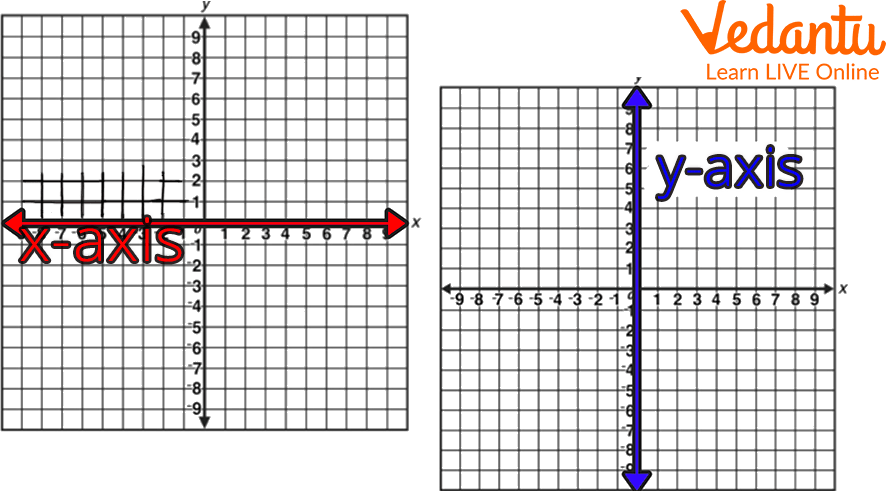
X and Y Axis
The graph of the x-axis or graph of x is also referred to as the abscissa. The graph of the y-axis is also referred to as the ordinate. Any point on the coordinate plane is well defined by an ordered pair, which is written as (x-coordinate,y-coordinate) or (x,y), where x-coordinate denotes a point on the x-axis or at a perpendicular angle from the y-axis and y-coordinate denotes a point on the y-axis or at a perpendicular angle from the x-axis.
Each perpendicular line in an x and y graph represents one of the four quadrants with positive and negative coordinates.
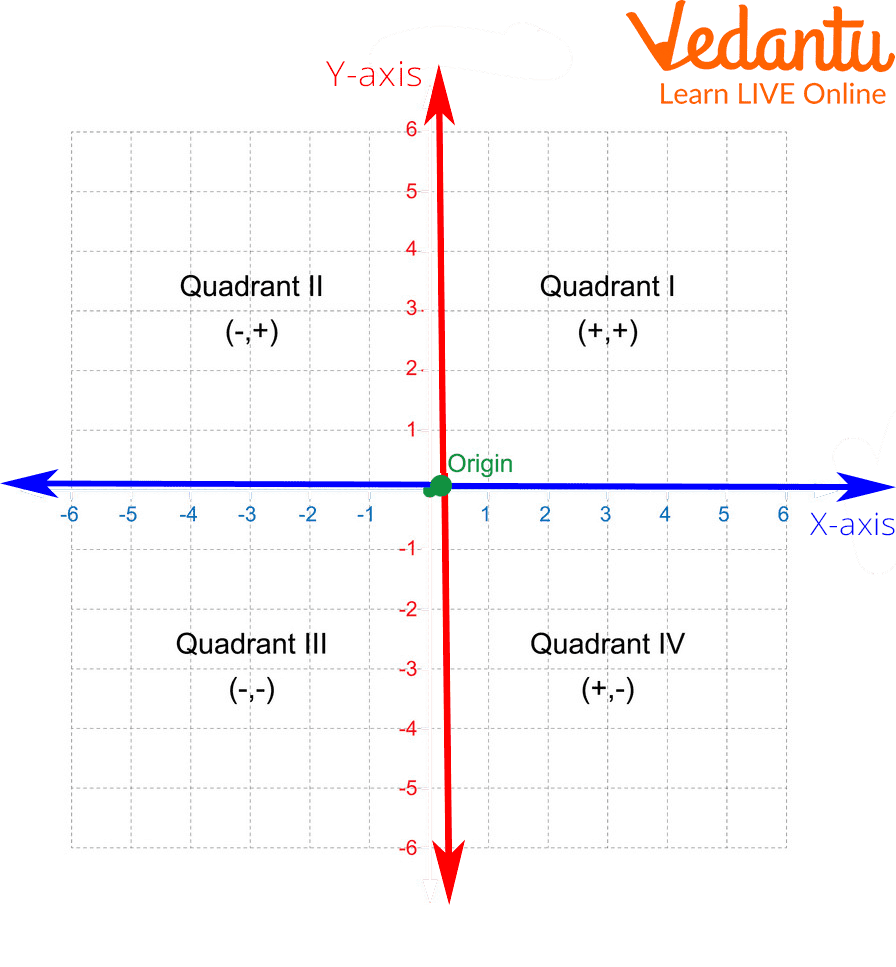
Quadrants in a Graph
Example: Number of minutes of commercials in one hour of television since 2009-
We use an ordered pair to find any point on the coordinate plane. The ordered pair is written as (x-coordinate,y-coordinate) or (x, y), where x-coordinate denotes a point on the x-axis or perpendicular distance from the y-axis and y-coordinate denotes a point on the y-axis or perpendicular distance from the graph of x-axis.
As we can see, each point's location on the graph is indicated by an ordered pair, with the x-axis or x-coordinate coming first and the y-axis or y-coordinate coming second. Using years as the x-axis and the number of minutes of commercials in one hour of television as the y-axis, depict these points as follows on the x and y chart.
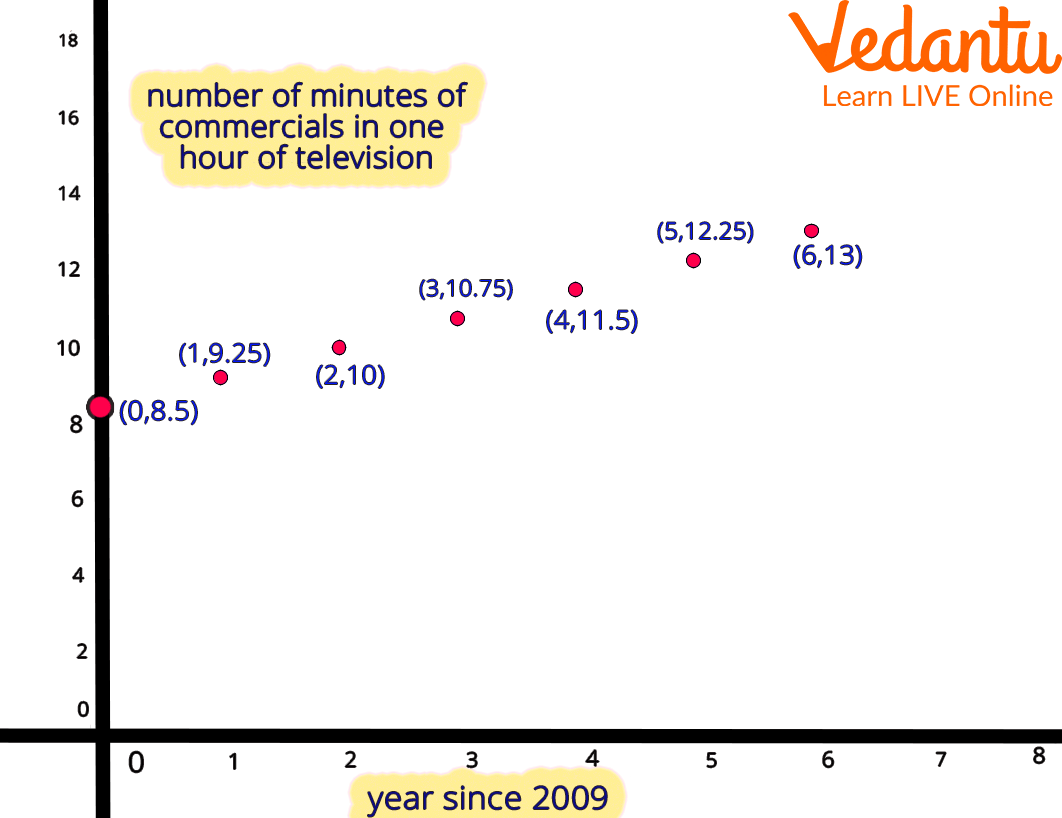
Example of X and Y Graph
Line Graph- x and y-axis
A horizontal x-axis and a vertical y-axis make up the line graph. These axes often cross around the bottom of the y-axis and the left end of the x-axis because the majority of line graphs only deal with positive numerical values. The intersection of the axes is always at (0,0). A data type is listed next to each axis. The x-axis could represent days, weeks, quarters, or years, for instance, while the y-axis displays revenue in dollars.
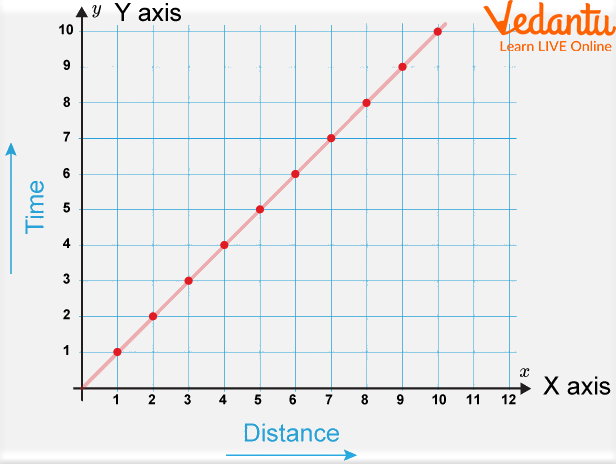
Line Graph with X and Y-axis
Graph of Relation (Relation Graph)
The set of all points (x, y) in a coordinate plane such that x is related to y by the relation R is known as the graph of a relation R. It is possible to graph a relation (relation graph) made up of infinitely many ordered pairs of numbers using just point plotting.
Illustration: The given diagram shows a relation graph.
$R=\{(2,5),(4,3),(6,1),(2,7)\}$
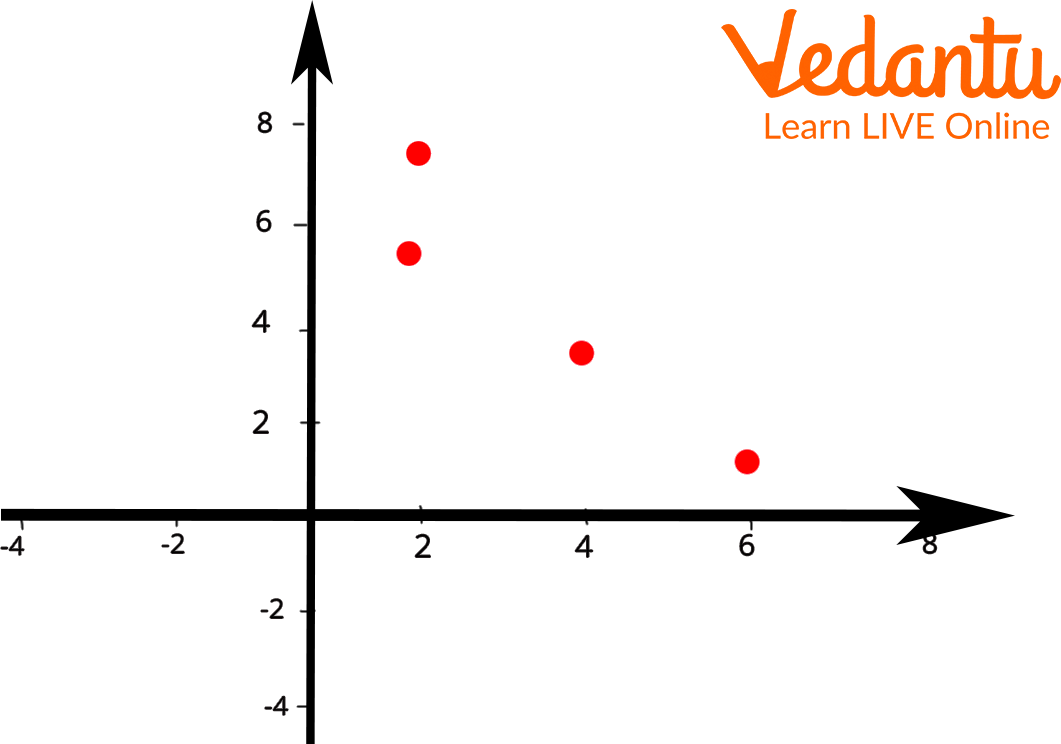
Relation Graph
Solved Examples
Q 1. Draw a line graph to represent the data from the table.
Ans:
Q 2. A number of weeks vs rainfall. Plot the graph from the given data
Week- 1 2 3 4 5
Rainfall - 23 21 17 19 24
Ans:
Practice Problems
Q 1. Plot a line graph from the given data of x and y respectively.
Q 2. Draw the line graph showing the following table.
Q 3. Draw the line graph:
Summary
A line graph has two axes: a horizontal x-axis and a vertical y-axis (vertical). The sites where the axes connect each indicate a distinct type of data, and (0, 0). Because its values are independent of any variables being measured, the x-axis is known as the independent axis. In the given article we have discussed the X and Y graphs. Definition of X and Y graphs and graph x and y-axis are given with the graph of relation in this article.
FAQs on Mastering Line Graphs: Meaning, X and Y Axes Explained
1. What is a line graph and what is its main purpose in Maths?
A line graph is a type of chart used to show information that changes over a period of time. It consists of a horizontal x-axis and a vertical y-axis. Data points are plotted on the graph and connected with straight lines. Its primary purpose is to visually represent a trend or a relationship between two variables, making it easy to see how one quantity changes in relation to another, such as tracking temperature changes throughout a day.
2. How are the x-axis and y-axis defined on a line graph?
In a line graph, the two axes form the foundation for plotting data. Their roles are distinct:
The x-axis is the horizontal line at the bottom of the graph. It typically represents the independent variable, which is a value that is constant or changes at a standard rate, like time (hours, days, or months).
The y-axis is the vertical line on the side of the graph. It represents the dependent variable, which is the value that is measured and changes in response to the independent variable, like temperature, sales figures, or height.
3. What is the importance of an independent and a dependent variable on a line graph's axes?
The distinction between independent (on the x-axis) and dependent (on the y-axis) variables is crucial because it establishes a cause-and-effect relationship. The line graph is designed to show how the dependent variable 'depends on' or 'changes because of' the independent variable. For instance, in a graph showing plant growth over time, 'time' is independent (it passes regardless), while 'plant growth' is dependent (it changes based on time). This setup helps in analysing and understanding data trends correctly.
4. Can you give a real-world example of data plotted on a line graph using the x and y-axis?
Certainly. Imagine tracking the number of daily visitors to a website over one week.
- The x-axis would represent the independent variable: the days of the week (Monday, Tuesday, Wednesday, etc.).
- The y-axis would represent the dependent variable: the number of visitors.
5. How is a line graph different from a bar graph in terms of how they use the x and y-axis?
The key difference lies in the type of data they represent. A line graph uses the x-axis to show continuous data, like time or temperature, and the line connecting the points shows a continuous trend. In contrast, a bar graph uses the x-axis to represent discrete categories, such as different countries, types of fruits, or student names. A bar graph is used for comparison between these separate categories, whereas a line graph is used to track change over a continuous interval.
6. What does the origin (0,0) represent on a line graph?
The origin (0,0) on a line graph is the point where the x-axis and y-axis intersect. It serves as the starting or reference point for all measurements on the graph. At the origin, the value for both the independent variable (on the x-axis) and the dependent variable (on the y-axis) is zero. For example, in a graph showing distance travelled over time, the origin represents the start of the journey—zero time elapsed and zero distance covered.
7. How do the four quadrants of a graph affect the data shown in a line graph?
The coordinate plane is divided into four quadrants by the x and y-axes. While many basic line graphs use only Quadrant I (where both x and y values are positive), the other quadrants are used for data involving negative values. For example:
- A graph showing a company's profit over several quarters might use Quadrant I for profits (positive values) and Quadrant IV (positive x, negative y) to show losses.
- A science experiment tracking temperature changes above and below freezing would use Quadrant I for temperatures above 0°C and Quadrant IV for temperatures below 0°C.























